0615 Chapter six is titled, “The Infrastructure of Belief”.
Le Bon sets the metaphor. If beliefs are like buildings, then what are the main pillars that hold up the construction? Once identified, the infrastructure of belief may account for how propaganda is more persuasive than appeals to logic. Propaganda targets the infrastructure of belief.
0616 Le Bon identifies five pillars. Stiles claims that these pillars are hard-wired into the human brain. She also says that they correspond to trusted sources in a community.
Here is a list of pillars, along with the corresponding trust.
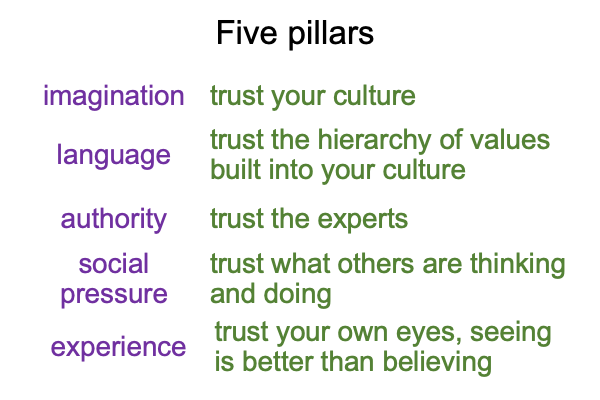
0617 Where would the pillars apply in the post-truth interscope?
In modern construction, the soil is too unstable to support a multi-story structure of concrete and steel. So, architects call for pillars to be driven down, into the bedrock, which may be under meters of soil, in order to assure the stability of the ground beneath the building. In effect, the pillars drive through the organic material above the bedrock with shafts of steel-reinforced concrete.
Unfortunately, if modern construction serves as a metaphor. Then, the organic material above the bedrock, what we otherwise would call the “ground”, is the thing that the pillars of the elite edifice of the situation and perspective levels of the post-truth interscope pass through.
0618 In other words, the five pillars drive through the content-level actuality, which is the contiguity between what I thinkand what I am willing to say.
The pillar-driving metaphor offers another avenue for appreciating Stiles’s argument.
0619 In the following diagram, I arrange the five pillars so that they drive through the bubbles for what I think and the ellipse for what I say. I do so by putting Le Bon terms as drivers (proceeding from the top) and reinforcers (supporting from the bottom).
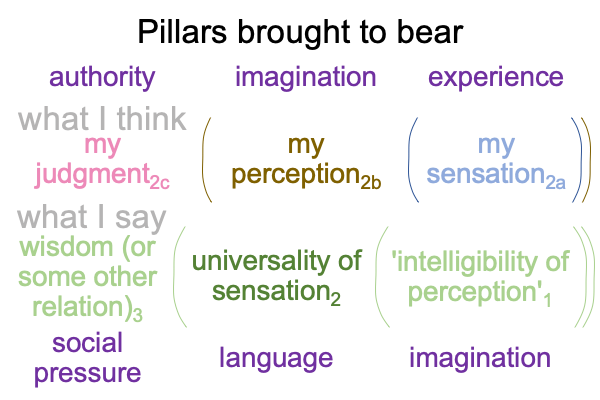
0620 Let me start with thirdness.
Authority comes down on my judgment. Only I have the authority to bring the intelligibility of my perceptions into relation with the universality of my sensations. Only I have the authority to relate my emotions to my feelings. Only I have the authority to relate what I think is going on with what I see going on around me. Until, of course, I find myself wrapped up in the sign-object of an interventional sign-relation.
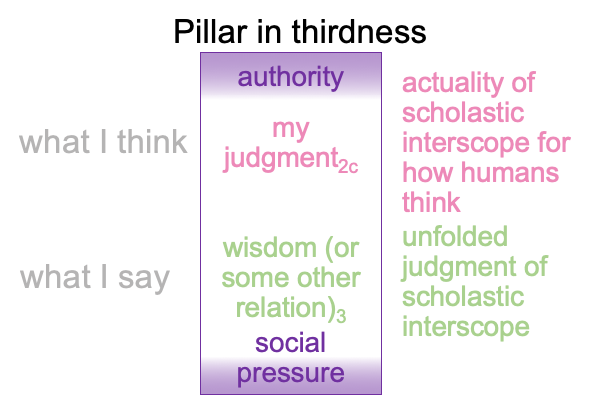
Social pressure moves aside any wisdom that I might say. Remember that wisdom (thirdness) is the relation between the intelligibility of my perception (what ought to be, firstness) and the universality of my sensation (what is, secondness). Social pressure works directly on wisdom, replacing it with its own, already formulated denkstyle.
0621 What about secondness?
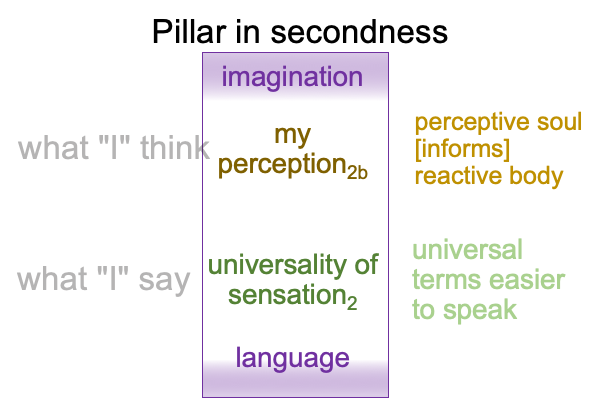
Imagination is a potential underlying perception. But, this is not my imagination. This is the imagination that is wrapped up in stagecraft. In regards to what I think, imagination makes the perception that stagecrafters want me to conjure more real, but not necessarily more intelligible. Oh, their imaginary perception may seem more intelligible, because it is already embedded in the staged event.
Language can drive through the universality of sensation. Sensation is the gateway to perception. What is happeningunderlies what it means to me. Sensation associates to the active body (complete with its five senses and internal sensing mechanisms) substantiating the sensate soul (the actuality of feelings, qualia and experience, in the most foundational sense of the words). When I turn to my colleague and ask, “Did you feel that?”, “that” is a sensation.
If my colleague (or a broadcast announcer) offers a statement formulating how I should feel, then that statement is decoded immediately, because sensation is universal. In staged events, a reporter tells me what my sensations are. So, when I hear about an “unprovoked attack”, then I know how that feels. It feels like being mugged.
0622 What about firstness?
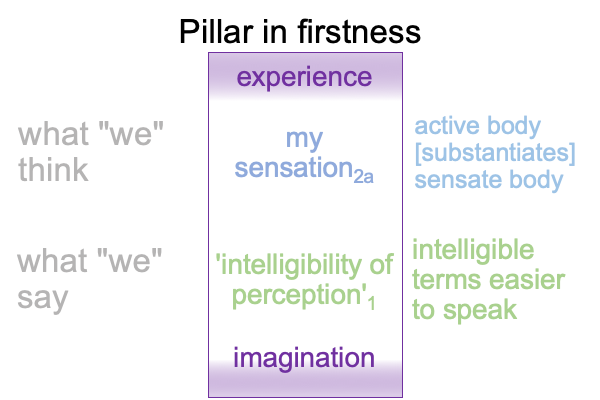
0623 In regards to what I say, externally driven imagination makes perception more plausible. The person hearing the speaker’s words has to wonder, “Would this make sense if I were in the speaker’s situation?”
Imagination targets intelligibility from below. Firsthand reports are so effective in stagecraft. If what a so-called “victim” says adds to the plausibility of the narrative, then that goes right through any scrappy player’s attempts to figure out what really happened. Stiles tells the story of Elizabeth O’Bagy, who wrote an op-ed in the Wall Street Journal about her first-hand knowledge of the “moderate” Syrian opposition. Her op-ed turned into a lesson in stagecraft.
0624 From above, the scrappy player allows his own experiences of prior staged events to color the way his active body substantiates his sensate soul. If a person lives through one lockdown, then a later, second, lockdown is less shocking. If the person is confronted with one police officer asking for papers, the person is less shocked when police officers show up in the subway, asking to look in people’s bags. Habituation is crucial.
The window of stagecraft always shifts towards greater surveillance (the experts need data to do their job) and control(including, the political power necessary to conduct psychometric experiments).
